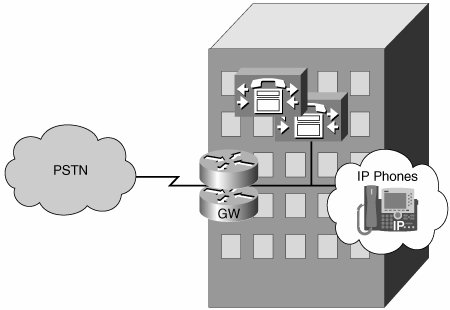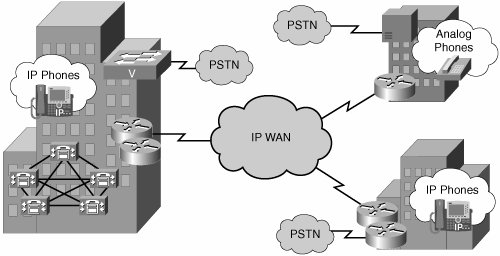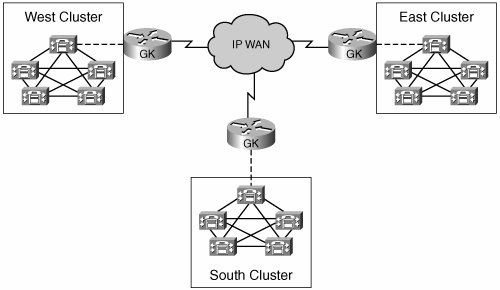Deployment Scenarios
Three typical CallManager deployment scenarios exist:
- Single site
- Multisite with centralized call control
- Multisite with distributed call control
Each scenario has different ways of using gateways and gatekeepers.
Single Site Deployment
In the single site model, a central call agent serves one location, such as a building or campus. In small sites, this might be a Cisco CME. Larger sites might use a CallManager cluster. All telephones calls outside the site are sent through the PSTN. Telephone calls within the site traverse the LAN or perhaps metropolitan-area network (MAN). Figure 1-4 shows a typical single site deployment.
Figure 1-4. Single Site Deployment

The example shows a small CallManager cluster used as the call agent. In this deployment, gatekeepers are not needed. Gateways connect the LAN to the PSTN, and sometimes to a PBX. For added redundancy, two gateway routers are used. The G.711 codec is used, because bandwidth is not an issue. The gateway Digital Signal Processor (DSP) resources provide conferencing and media termination point (MTP) resources. To simplify gateway configuration, MGCP is used as the call control protocol. If some specific H.323 or SIP functionality is needed, you could use those protocols instead.
Multisite with Centralized Call Control
A company uses this type of deployment when it wants to include multiple sites in its VoIP network, but centralize the call agents. Typically, a CallManager cluster is located at the headquarters or data center site, with perhaps redundant servers at a backup site. The IP phones in remote locations register to the centralized CallManagers, in a hub-and-spoke type arrangement. Remote sites are connected in a full mesh across an IP WAN. Both call signaling and IP voice are sent over the WAN. PSTN access is usually still provided locally. Figure 1-5 illustrates this type of scenario.
Figure 1-5. Multisite Deployment with Centralized Call Control

The gateways at each location interface with the PSTN, the LAN, and the IP WAN. They might also interface with a PBX at some sites. They provide backup call processing by using SRST if the CallManagers are not available because of WAN failure. You can use the G.729 codec across the WAN; use quality of service (QoS) for best results. A gatekeeper is not required for call admission control, but you can use it for dial plan resolution if many remote sites exist.
Multisite Deployment with Distributed Call Control
If the number of remotes sites grows unwieldy, or sites are widely distributed, you can use a multisite scenario with distributed call control. Each "site" in this scenario might be one of three types:
- A single location or campus using CallManager, CME, or another IP PBX
- A multisite CallManager cluster with centralized call control
- A site with a legacy PBX and a VoIP gateway
Figure 1-6 shows an example of this type of network.
Figure 1-6. Multisite Deployment with Distributed Call Control

Multiple CallManager clusters are used, and gatekeepers are used for at least call admission control and address resolution. You can add a directory gatekeeper to scale the gatekeeper implementation. If gatekeepers are used, H.323 gateways are used also. Sites are connected across an IP WAN, with PSTN backup in case of WAN failure or insufficient bandwidth. You typically use the G.729 codec across the IP WAN. Use QoS for best results.
Part I: Voice Gateways and Gatekeepers
Gateways and Gatekeepers
- Gateways and Gatekeepers
- The Role of Voice Gateways
- The Role of Voice Gatekeepers
- The Role of IP-to-IP Gateways
- Introduction to Voice Protocols
- Call Control Agents
- Deployment Scenarios
- Case Study: Introduction
- Chapter Review Questions
Part II: Gateways
Media Gateway Control Protocol
- Media Gateway Control Protocol
- Introduction to MGCP
- MGCP Operation
- Call Flow with MGCP
- Dial Plan Considerations
- Implementing MGCP Gateways
- Securing MGCP Gateways
- Troubleshooting Tools
- Case Study: Configuring an MGCP Gateway
- Review Questions
H.323
- H.323
- H.323 Specifications
- H.323 Network Components
- Call Flow
- H.323 Protocol Pros and Cons
- When to Use H.323
- Dial Plan Considerations
- Implementing H.323 Gateways
- Securing H.323 Gateways
- Troubleshooting Tools
- Case Study: Configuring an H.323 Gateway
- Review Questions
Session Initiation Protocol
- Session Initiation Protocol
- Description of SIP
- SIP Call Flow
- SIP Pros and Cons
- When to Use SIP
- Dial Plan Considerations
- Implementing SIP Gateways
- Securing SIP Gateways
- Allowing H.323 to SIP Connections
- Troubleshooting Tools
- Case Study: Configuring SIP Between a Gateway and CallManager 5.x
- Review Questions
Circuit Options
Connecting to the PSTN
- Connecting to the PSTN
- PSTN Circuit Selection Overview
- Analog Trunks
- Digital Trunks
- Case Study: Add an E1 R2 Connection to the Leeds Gateway
- Review Questions
Connecting to PBXs
- Connecting to PBXs
- Analog Trunks
- Digital Trunks
- Configuring Transparent Common Channel Signaling
- Case Study: Implementing a Cisco Voice Gateway at the Shanghai Office
- Review Questions
Connecting to an IP WAN
- Connecting to an IP WAN
- Applications for Connecting to an IP WAN
- Design Considerations
- Quality of Service
- Providing Fax and Modem Services
- Security
- Case Study: Using a T1 Link as a Tie Line
- Review Questions
Dial Plans
- Dial Plans
- Numbering Plans
- Overlapping Numbering Plans
- Building a Scalable Dial Plan
- Dial Peers
- Dial Peer Matching
- Case Study: Configuring PSTN Access
- Review Questions
Digit Manipulation
- Digit Manipulation
- Basic Digit Manipulation
- Number Expansion
- Voice Translation Rules and Profiles
- Manipulating Caller ID
- Order of Operation in Digit Manipulation
- Troubleshooting Digit Manipulation
- Case Study
- Review Questions
Influencing Path Selection
- Influencing Path Selection
- Hunt Groups
- Using Trunk Groups
- Tail-End Hop-Off
- Call Admission Control
- POTS-to-POTS Call Routing Considerations
- Case Study: Implementing Gateway-Controlled RSVP
- Review Questions
Configuring Class of Restrictions
- Configuring Class of Restrictions
- COR Overview
- COR Operation
- Implementing COR
- Assigning COR Lists with SRST
- Assigning COR Lists with Cisco CallManager Express
- Restricting Inbound Calls
- Case Study: Implementing COR for Miami
- Review Questions
SRST and MGCP Gateway Fallback
- SRST and MGCP Gateway Fallback
- SRST Overview
- Configuring SRST
- Dial Plan Considerations
- SRST Features
- SIP SRST
- Call Preservation
- Secure SRST
- MGCP Gateway Fallback
- Configuring MGCP Gateway Fallback
- Verifying and Troubleshooting SRST
- Verifying and Troubleshooting MGCP Gateway Fallback
- Case Study: Integrating SRST with an Analog Voice-Mail System
- Review Questions
DSP Resources
- DSP Resources
- Need for DSP Resources
- Determining the DSP Resources Required
- Configuring DSP Resources
- Transcoding for CallManager Express
- Case Study: Add DSP Resources to the Miami Gateway
- Review Questions
Using Tcl Scripts and VoiceXML
- Using Tcl Scripts and VoiceXML
- Tcl IVR and VoiceXML Application Overview
- Sample Applications
- Downloading Tcl Scripts from Cisco.com
- Configuring the Gateway to Use a Tcl Script
- Implementing the AA Tcl Script
- Creating Audio Files
- Restrictions and Caveats
- Case Study: Implementing ACD Application
- Review Questions
Part III: Gatekeepers
Deploying Gatekeepers
- Deploying Gatekeepers
- Gatekeeper Functionality
- Gatekeeper Signaling
- E.164 Number Resolution
- Call Admission Control
- Gatekeeper Deployment Models
- Gatekeepers with CallManager
- Security with Gatekeepers
- Review Questions
Gatekeeper Configuration
- Gatekeeper Configuration
- Configuring Basic Gatekeeper Functionality
- Multiple Gatekeeper Configurations
- Configuring Directory Gatekeepers
- Troubleshooting Gatekeepers
- CallManager and Gatekeepers
- Gatekeeper Redundancy
- Configuring Resource Availability Indicator
- Configuring Gatekeeper Security
- Case Study: Deploying Gatekeepers to Assist in Migration to VoIP
- Review Questions
Part IV: IP-to-IP Gateways
Cisco Multiservice IP-to-IP Gateway
- Cisco Multiservice IP-to-IP Gateway
- IP-to-IP Gateway Overview
- Cisco Multiservice IP-to-IP Gateway
- Basic Configuration
- IP-to-IP Gateway Features
- Case Study: Providing Enterprise VoIP Trunking to VoIP Service of the Service Provider
- Review Questions
Appendix A. Answers to Chapter-Ending Review Questions
Index
EAN: 2147483647
Pages: 218
